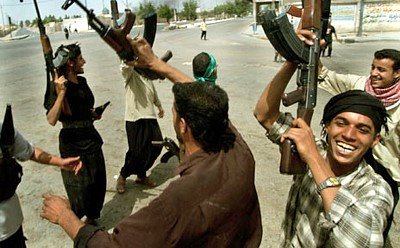Analysis: Militias splintering into radicalized cells

BAGHDAD -- The young Shiite men, some wearing black masks, glided from house to house in search of Sunni Muslim men. They arrived at the two-story dwelling of Mohammed Hussein clutching a bomb, neighbors said. As his mother stood at the front gate, they detonated it. Shrapnel and glass flew, sending her to the hospital. A wall fell on a neighbor, sending him to his grave.
Hussein, who is Sunni, arrived home an hour later and immediately blamed a man called Aziz Dinar. Residents in this western Baghdad neighborhood of Hurriyah -- in Arabic, it means freedom -- said Dinar heads the local office of Shiite cleric Moqtada al-Sadr and elements of his militia, the Mahdi Army.
"We know he is behind all the incidents taking place in Hurriyah," Hussein, 29, a civil servant, said with confidence. "He is the one who destroyed our house."
But in an interview, a leader in Sadr's movement in western Baghdad denied knowing Dinar. "This Aziz Dinar does not represent us in Hurriyah. There are other representatives," said Abdul Hadi al-Mohammadawi. "I have never heard of him."
In the void forged by the sectarian tensions gripping Baghdad, militias are further splintering into smaller, more radicalized cells, signifying a new and potentially more volatile phase in the struggle for the capital.
Iraqis and U.S. officials blame militias for mass kidnappings and slayings, for setting up unauthorized checkpoints and for causing much of the recent carnage.
Senior U.S. military and intelligence officials say they have identified at least 23 militias -- some are Sunni, but most are Shiite. Some are paramilitary offshoots of the Mahdi Army or have broken away entirely from Sadr's command structure. Others seem inspired by Lebanon's Shiite Hezbollah guerrilla movement.
"In some ways it makes it easier for me because I have digestible doses I can deal with that might not be reinforcing one another," a senior U.S. military official said at a recent briefing with reporters, speaking on condition of anonymity. "But at the same time, it creates problems for me because it is harder to find them when they are splintered, to identify who they are."
The new breed of militias embody the changed texture of violence in the fourth year of war -- from attacks against Baathists and loyalists of former Iraqi president Saddam Hussein, to attacks on average Iraqis purely because of their sect or their wealth. They appear more localized and more ruthless than their predecessors. They deploy death squads and explode bombs to destroy houses. They have carved neighborhoods into fiefdoms, governing through fear and intimidation.
Read the rest at the Washington Post

<< Home